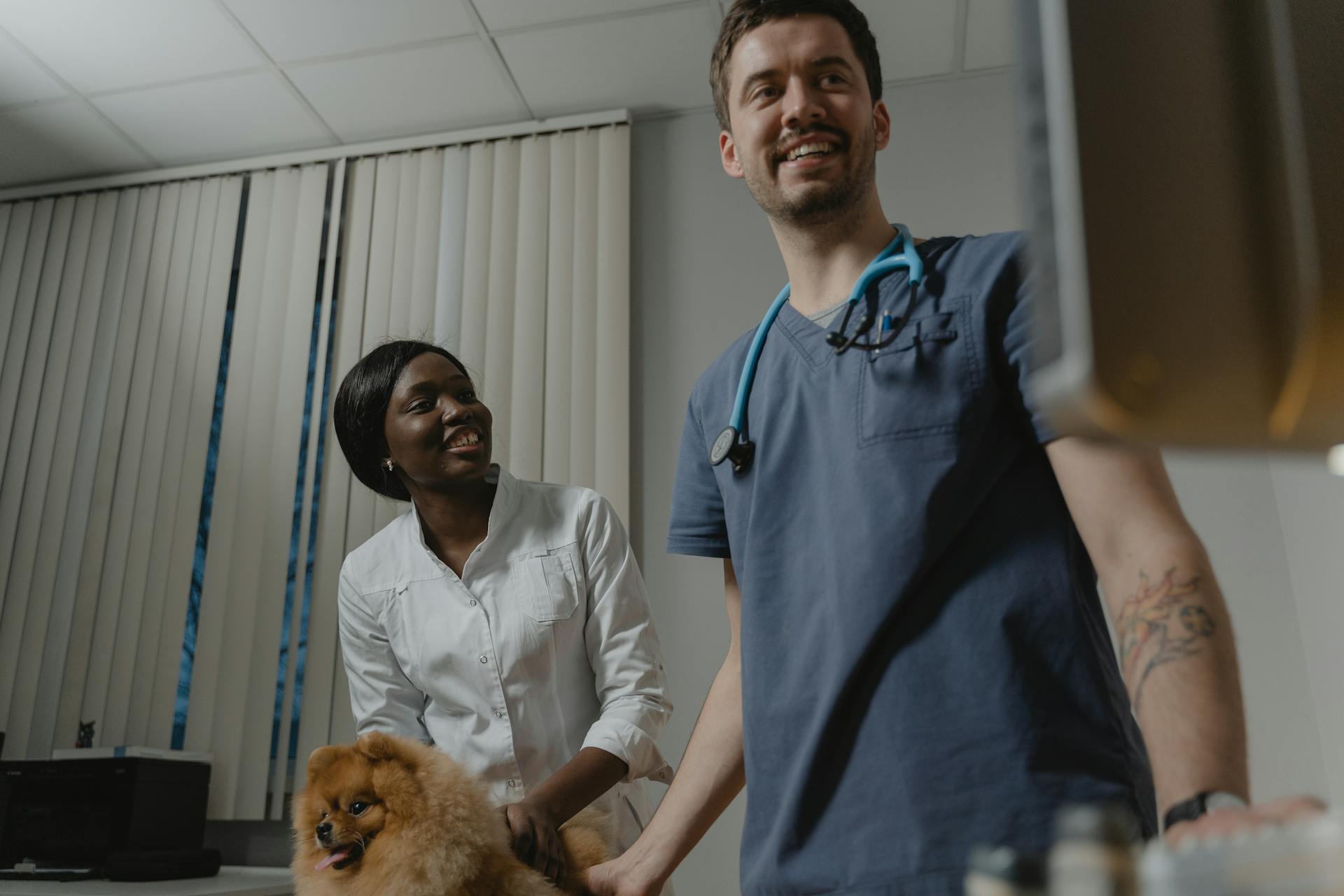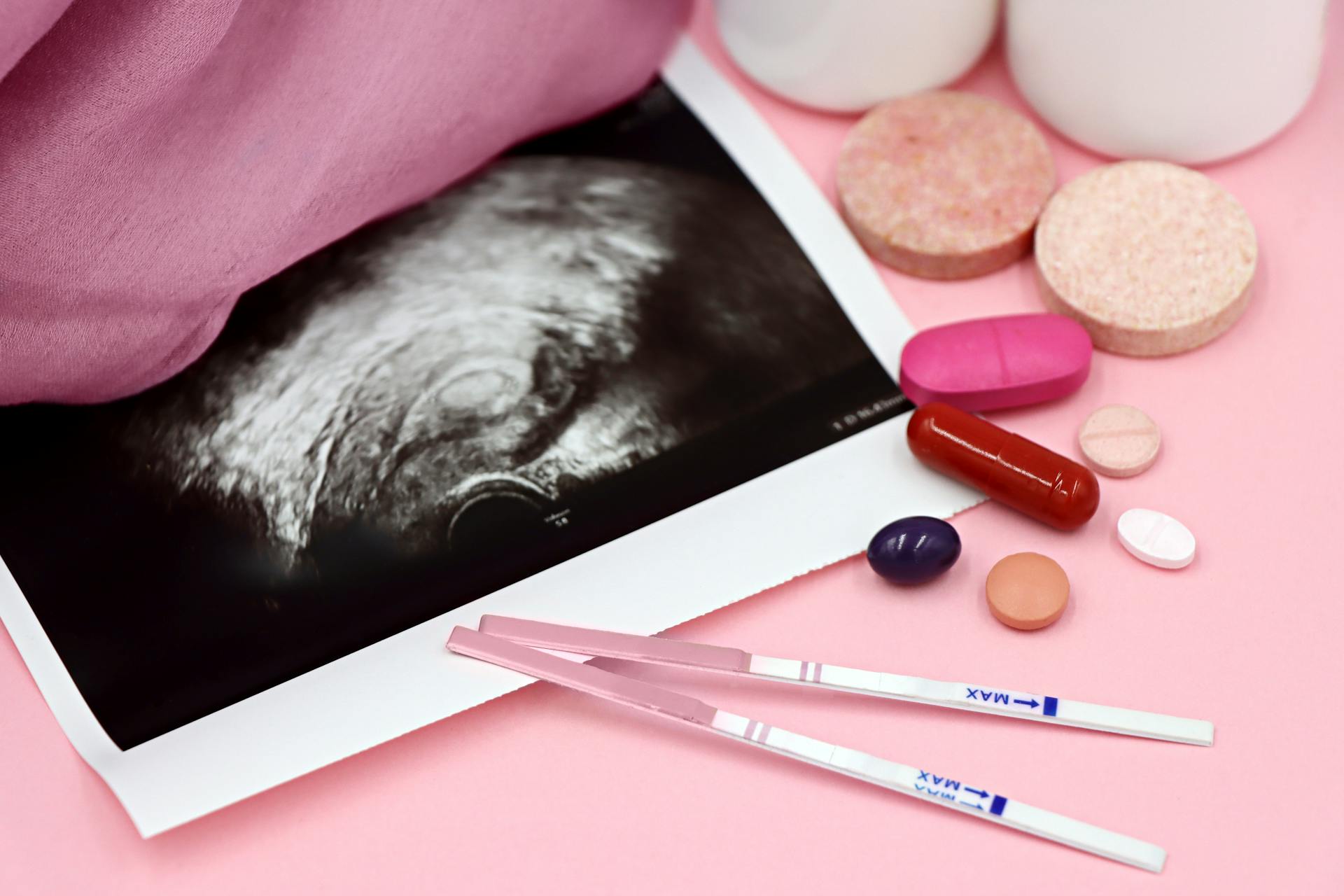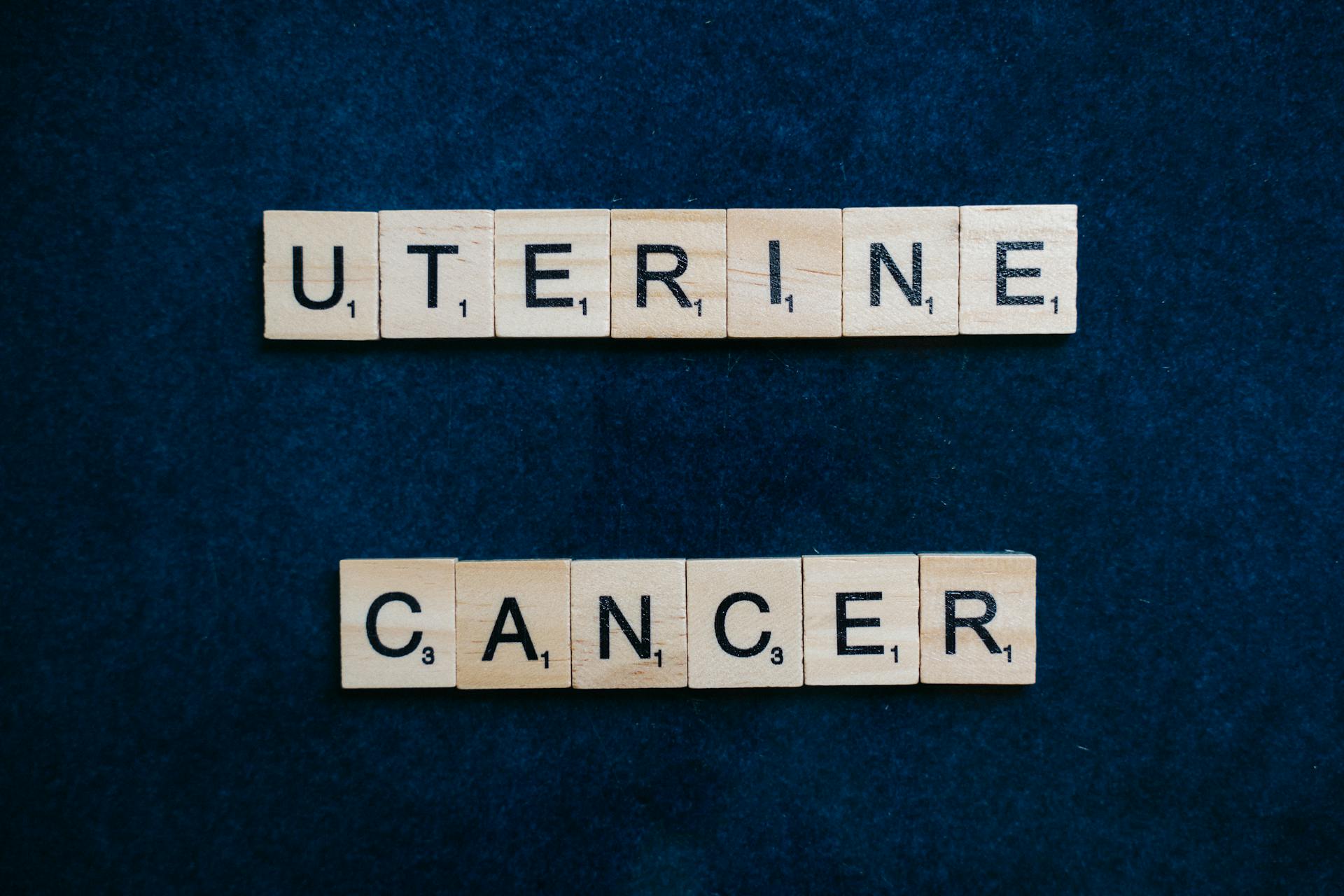
The female dog reproductive cycle is a natural process that's essential to understand, especially if you're a dog owner. A typical heat cycle in a female dog lasts around 2-3 weeks, with the first sign of heat being a bloody discharge or "heat".
This discharge is a result of the hormonal changes that occur in the female dog's body, specifically the increase of estrogen levels. As the heat cycle progresses, the discharge will become more frequent and eventually stop.
Female dogs typically have their first heat cycle between 6-12 months of age, but it's not uncommon for some breeds to have their first heat cycle earlier or later than this range. Some breeds, such as the German Shepherd, tend to mature earlier than others.
The female dog's reproductive cycle is regulated by hormones, specifically estrogen and progesterone, which control the different stages of the cycle.
On a similar theme: Female Dog Estrous Cycle
What Are the Signs?
You may notice that your dog's vulva is swollen and bleeding during the proestrus stage, which is usually the first sign of heat. This stage typically lasts for a few days.
During proestrus, your dog may also exhibit behaviors like holding or tucking her tail closer to her body, increased clinginess, changes in appetite, and aggression toward male dogs.
You can expect your dog to bleed for around half of the total heat cycle, usually 7 to 10 days. This can vary between dogs, with bigger dogs bleeding more than smaller ones.
Some dogs may bleed very little, especially if they're meticulous about their grooming. In these cases, you might not notice any blood spotting around the house.
As your dog's heat cycle progresses, you may notice changes in her behavior, such as being overly friendly with other dogs, seeking out male dogs, mounting or humping, turning her tail to the side, and fidgeting or being nervous.
You might enjoy: Why Does My Male Dog Lick My Female Dogs Ear
Spaying and Neutering
Spaying your dog is one of the most important decisions you'll make as a pet owner. Getting your dog spayed as soon as possible is the best way to prevent your dog from getting pregnant, especially if they spend a lot of time around other dogs.
Expand your knowledge: How to Keep Female Dog from Getting Pregnant
The American Animal Hospital Association recommends spaying before your dog's first heat cycle, which is between five to six months of age for breeds that weigh less than 45 pounds when fully grown. For larger breeds, it's recommended to wait until they're between 5-15 months old.
Spaying your dog can have multiple health benefits, including reducing the risk of breast cancer and pyometra, a potentially fatal uterine infection. In fact, a 2013 study found that the life expectancy of spayed female dogs was 26.3% longer than that of unspayed dogs.
Spaying your dog also reduces the production of hormones that can contribute to the growth of mammary gland tumors, which is the most common type of tumor in unspayed female dogs. About half of mammary gland tumors in dogs are cancerous.
Here are the risks of developing mammary cancer based on the timing of spaying:
- 0.5% risk if spayed before the first heat cycle
- 8% risk if spayed between the first and second heat cycles
- 25% risk if spayed any time after the second heat cycle
Spaying your dog can also reduce certain behavioral problems, including aggression, roaming, excessive vocalizing, and urine marking.
The Estrus Cycle
The canine estrus cycle has four stages: proestrus, estrus, diestrus, and anestrus.
Proestrus is the beginning of heat, lasting between 7 and 10 days, during which the vulva begins to swell and bleeding starts, attracting male dogs but not yet ready to mate.
Estrus is the mating period, lasting 5 to 10 days, where bleeding may be reduced or stop, and your dog is ready to mate.
Diestrus can last anywhere from 10 to 140 days, and your dog is either pregnant or in a period of rest.
Anestrus is the period of downtime before the next heat cycle, lasting around 6 months.
Here's a breakdown of the stages:
Your dog's size, breed, and age will determine the exact frequency of her estrus cycles, but generally, female dogs go into heat twice a year, around every 6 months.
Breeding and Reproduction
Female dogs typically go into heat for the first time when they're between 6 months to 1 year old, but it's best to wait until they've had 2 or 3 heat cycles for their health.
Most female dogs will be ready to breed around 2 years old, after they've had a few heat cycles. This is when they're most fertile and have the best chance of getting pregnant.
To breed your female dog, you'll need to find a suitable male dog with no genetic faults or issues. Meet with the male dog's owner beforehand to discuss the dog's health and medical history.
Female dogs are ready to breed during the estrus stage of the heat cycle, which typically lasts for around 9 days. Try to set up breeding during this period for the best chance of success.
Here's a quick checklist for breeding your female dog:
- Wait until your dog has had 2 to 3 heat cycles
- Find a suitable male dog with no genetic faults or issues
- Meet with the male dog's owner beforehand to discuss health and medical history
- Set up breeding during the estrus stage of the heat cycle
Breeding Your Dog
Waiting until your dog has had a few heat cycles is crucial for her health. Typically, this is when your dog is around 2 years old.
You'll need to find a suitable male dog for breeding, one that's healthy and has no genetic faults or issues. Meet with the male dog's owner beforehand to discuss the dog's health and medical history.
You might enjoy: Dog Names Female Start with S
Female dogs are ready to breed during the estrus stage of the heat cycle, which lasts for around 9 days. Try to set up the breeding during this period for the best chance of getting pregnant.
The ideal time to breed your dog is after the bloody vaginal discharge, when she's most fertile. This is when she'll be most receptive to the male dog.
It's essential to create a stress-free environment for the breeding, as male dogs do better mating in their own territory.
Suggestion: Male Reproductive System in Dogs
Cross Breeding
Cross breeding is a deliberate process of combining two established breeds to create a new mixed-breed dog.
This method has shown to produce dogs with desirable reproductive traits, such as superior mothers who can produce more milk and give better care to their offspring.
Cross-bred females have been found to have decreased mortality in their offspring, making this a beneficial practice for many breeders.
The qualities of cross-bred dogs, however, are not predictable, making it challenging to determine their characteristics.
For example, a Labrador x Poodle ("Labradoodle") can inherit the coat of either a Labrador, a Poodle, or a mix of both.
Readers also liked: Labra Dog Female
Dog Anatomy and Physiology
The female dog reproductive system is quite different from the human female cycle, despite some similarities in appearance. In dogs, the uterus gets ready for implantation by leaking blood, causing a bloody discharge that lasts for 7 to 10 days.
Sexual maturity, or puberty, occurs in dogs between 6 and 12 months of age, although it can be delayed until up to two years of age for large breeds. This is a critical period for breeding and should be carefully managed.
Dogs can become pregnant as soon as their first estrus cycle, but breeding is not recommended before the second cycle. This allows for a more stable and healthy breeding process.
Readers also liked: When Should I Spay My Female Dog
Care and Clinical Issues
If your dog is in heat, she'll require a bit of extra supervision and care. She'll be feeling hormonal and might attract male dogs, so it's essential to keep her away from other non-neutered dogs to avoid pregnancy.
Recommended read: Female Beagle Dogs
Keeping your dog entertained and distracted will help relieve some of her anxiety and discomfort. Extra walks will also help her to reduce stress. Creating a limited space for her to roam in can also prevent accidents from occurring, especially if you're worried about her bleeding around the house.
You can create a nest for your dog to nap in with towels to catch the blood, and doggie diapers can also help control bleeding accidents. However, it's crucial to note that female dogs are at risk for uterine infections like endometritis and pyometra, especially after estrus or vaginitis.
Take a look at this: My Female Dog Is Bleeding
Care
Your dog will require extra supervision and care while she's in heat, as she'll be feeling hormonal and may attract male dogs.
To keep her entertained and distracted, extra walks will help reduce stress. You can also create a limited space for her to roam in, restricting her to easy-to-clean areas without carpeted floors or upholstered furniture.
A unique perspective: Does Spaying Calm down a Female Dog
A nest for your dog to nap in with towels to catch the blood will help prevent accidents from occurring. Doggie diapers can also help control bleeding accidents.
If you want to avoid pregnancy, consider having your dog surgically sterilized before her first season. This procedure is recommended before she's 6-months old, as the timing of the first heat cycle varies.
To minimize messes, consider putting your dog in a diaper.
See what others are reading: When Does a Female Dog Get Her First Heat
Clinical Issues
Female dogs are at risk for several clinical issues, including endometritis and pyometra, especially after giving birth, heat cycles, or vaginitis.
These infections can cause fever, lethargy, loss of appetite, and excessive thirst in dogs.
A foul-smelling vaginal discharge, which may or may not be bloody, can be a sign of uterine infection.
Infertility is also a potential consequence of untreated uterine infections.
Uterine infections can strike any intact female dog, regardless of whether she's been bred or not, and regardless of her age or breeding experience.
As dogs age, they become more susceptible to uterine infections, making regular check-ups with a veterinarian crucial for their health.
You might enjoy: Can Female Dog Get Pregnant When Not in Heat
Population and Expert Advice
During copulation, a male canine will sniff the female's vulva to determine if she's in the estrus stage, which is characterized by a secretion of Methyl p-hydroxybenzoate.
The male will often continue examining the female's rear, before mounting her from behind while attempting penetration with his penis. The female will stand still and hold her tail to the side, a stance referred to as "flagging", if she's receptive.
In canine copulation, the male first penetrates the female, and then his penis swells to erection, usually happening rapidly. The canine penis includes a narrow bone called the "baculum", which allows it to penetrate the female even when not erect.
The bulbus glandis, a spherical area of erectile tissue at the base of the penis, becomes engorged with blood during copulation, locking the penis inside the female's vagina. This is known as "tying" or "knotting".
You might like: When Can a Female Dog Get Pregnant during Heat
Population
Copulation is a unique process in canine behavior, where the male mounts the female from behind, a position known as "doggy style".

The male will first sniff the female's vulva to determine if she's in the estrus stage, which is indicated by a secretion of Methyl p-hydroxybenzoate.
If the female is receptive, she will stand still and hold her tail to the side, a stance referred to as "flagging".
The male will often continue examining the female's rear before mounting her from behind while attempting penetration with his penis.
Canine copulation involves the male first penetrating the female, after which swelling of the penis to erection occurs, usually rapidly.
The canine penis is not erect at the time of penetration, but includes a narrow bone called the "baculum" that allows it to penetrate the female.
Male canines are the only animals that have a locking bulbus glandis, a spherical area of erectile tissue at the base of the penis, which becomes engorged with blood during copulation.
This locking mechanism, also known as "tying" or "knotting", allows the penis to become locked inside the female's vagina.
The male will usually lift a leg and swing it over the female's back while turning around after the penis is locked inside the vagina.
After some time, typically between 5 and 20 minutes, the bulbus glandis disengorges, allowing the mates to separate.
Virgin dogs can become quite distressed at finding themselves unable to separate during their first copulation, and may try to pull away or run.
Expert Q&A

According to Dr. Maria Rodriguez, a leading demographer, "The world's population is expected to reach 9.7 billion by 2050, with the majority of growth occurring in Africa and Asia." This is a staggering number that highlights the need for sustainable population management.
Cities are expected to absorb the majority of this growth, with urban populations projected to reach 68% of the global total by 2050. This will put a strain on resources, infrastructure, and services.
Dr. John Lee, a renowned expert in population dynamics, emphasizes the importance of education and family planning in managing population growth. "Access to education and family planning resources is crucial in empowering women to make informed decisions about their reproductive health."
Frequently Asked Questions
How long after bleeding is a dog fertile?
After bleeding stops, a dog is likely to be fertile within 9-10 days, with peak fertility occurring shortly after. The end of bleeding is a more reliable indicator of peak fertility than the duration of bleeding itself.
Do female dogs have one or two holes?
Female dogs have two distinct openings: one for the vagina and another for the urethra, which drain into the vestibule. This unique anatomy is a key aspect of a dog's reproductive and urinary system.
Sources
- https://www.businessinsider.com/guides/pets/how-often-do-dogs-go-into-heat
- https://www.webmd.com/pets/dogs/how-tell-if-dogs-heat
- https://www.wikihow.com/Know-if-Your-Female-Dog-Is-Ready-to-Breed
- https://www.safarivet.com/care-topics/dogs-and-cats/reproduction/
- https://en.wikipedia.org/wiki/Canine_reproduction
Featured Images: pexels.com


